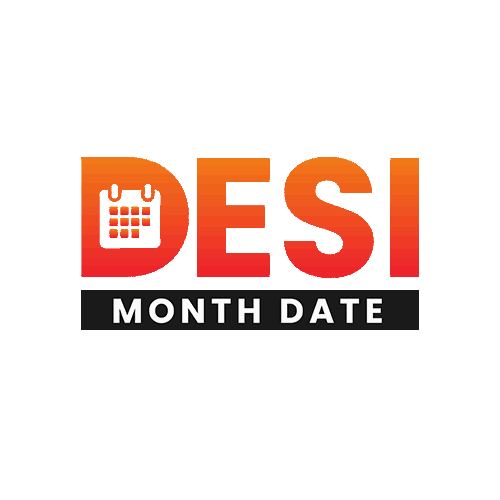The desi month date is an integral part of
the traditional Indian calendar system, a unique blend of astronomy, culture, and religion. Unlike the
Gregorian calendar, which is universally used today, the Desi calendar holds a
deep connection to the agricultural
cycles, seasonal changes, and religious observances of the Indian subcontinent. Understanding the Desi month date today
offers a fascinating glimpse into a world where time is measured not just by the
passage of days but by the rhythms of nature and spirituality.
The Structure of the Desi Calendar
The Today Desi Month
Date in Pakistan calendar, also
known as the Vikrami calendar, is lunisolar, meaning it is based on both the moon’s phases and the
solar year’s progress. Each month in this calendar begins with the new moon (Amavasya) and is divided into two
halves: the Shukla Paksha (waxing moon) and the Krishna Paksha (waning moon). This structure allows the
calendar to align with both the lunar and solar cycles, ensuring that festivals
and agricultural activities
are timed perfectly with natural events.
Each Desi month corresponds to specific
seasons and festivals. For instance, the month of Vaisakh, which falls around
April-May, is associated with the harvest festival of Baisakhi in Punjab. Similarly, Magh (January-February) is marked by the festival of Makar
Sankranti, celebrating the sun’s northward journey (Uttarayan) and the end of winter.
The Desi Date Today
Today’s Desi month date might be, for
example, the 5th of Sawan in the year 2081 Bikrami Samvat. Sawan, falling around July-August, is a month of heavy
monsoon rains in many parts of India, and it holds special significance in Hinduism.
It is a time when devotees of Lord Shiva observe various
rituals and fasts, particularly on Mondays, known as
Sawan Somvar.
The importance of the Desi date today extends
beyond mere ritual observance. It reflects the agricultural realities of the time, as farmers prepare for the
Kharif season, sowing crops like rice, maize, and cotton. The heavy rains of Sawan are crucial for these crops, and the
Desi calendar’s alignment with the monsoon ensures that farming activities are conducted at the optimal time.
Cultural and Religious Significance
The Desi month date is not just a marker of
time; it reflects India’s rich cultural and religious tapestry. Each month in the Desi calendar is associated
with specific deities, festivals, and rituals that have been observed for centuries. These observances are deeply
rooted in the agrarian lifestyle of the Indian subcontinent, where the success
of crops and the well-being of livestock are closely tied
to religious practices.
For instance, the month of Kartik
(October-November) is considered the most sacred in Hinduism. It is a time of intense religious activity, with devotees
observing the Kartik Purnima fast, participating in the ritual bathing in holy rivers, and lighting lamps in honor of
Lord Vishnu. The Desi date during this month is of particular importance as it determines the timing of these
rituals, ensuring they are performed at the most auspicious times.
Similarly, the month of Chet (March-April)
marks the beginning of the new year in many regions of India, including Punjab and Haryana.
The festival of Holi, celebrated during this month,
is a vibrant expression of joy and the triumph
of good over evil. The Desi date plays a crucial role in determining the exact day of the Holi festivities, which vary slightly
each year based on the lunar cycle.
The Desi Calendar
and Modern Life
In today’s fast-paced
world, where the Gregorian calendar dominates, the Desi calendar still holds a special place in the hearts
of many. It serves as a reminder
of India’s deep connection to nature and the cycles
of time that govern
life. Even as modern technology and globalized lifestyles push us toward a more
uniform understanding of time, the Desi month date continues to be
a source of cultural identity and pride.
For the millions of people who still rely on
the Desi calendar, particularly in rural areas, it is more than just a way to keep track of days. It is a living
tradition that ties them to their ancestors, their land, and their faith.
Whether it’s a farmer planning the
next crop cycle, a devotee observing a religious fast, or a community coming
together to celebrate a festival, the Desi date today has a
profound impact on daily life.
The Future
of the Desi Calendar
As India continues
to modernize, the relevance of the Desi calendar in everyday life may seem to diminish.
However, there is a growing recognition of the importance of preserving
cultural heritage. Efforts are being made to
integrate the Desi calendar with modern tools and technologies, ensuring
that future generations can continue to appreciate its significance.
One such effort includes the creation of
digital platforms and mobile apps that provide real-time updates on the Desi month date alongside the Gregorian date.
These tools help users stay connected with traditional observances while navigating the demands of modern life.
Additionally, educational initiatives are being launched to teach younger generations about the Desi calendar’s
history and importance, ensuring that this ancient system of timekeeping is not lost
to the sands of time.
Conclusion
The Desi month date today is more than just a point on a calendar. It is a living testament
to the Indian subcontinent’s
deep cultural and spiritual heritage. As we observe the Desi date today, we are
participating in a tradition that has
been passed down through generations, connecting us to our ancestors and the
natural world around us. Whether
through religious rituals, agricultural practices, or cultural celebrations,
the Desi calendar continues to play a
vital role in shaping the rhythms of life in India. In a world that often seems
to move too fast, the Desi month date
serves as a reminder of the importance of staying connected to the cycles of
nature and the rich traditions that define our identities.

